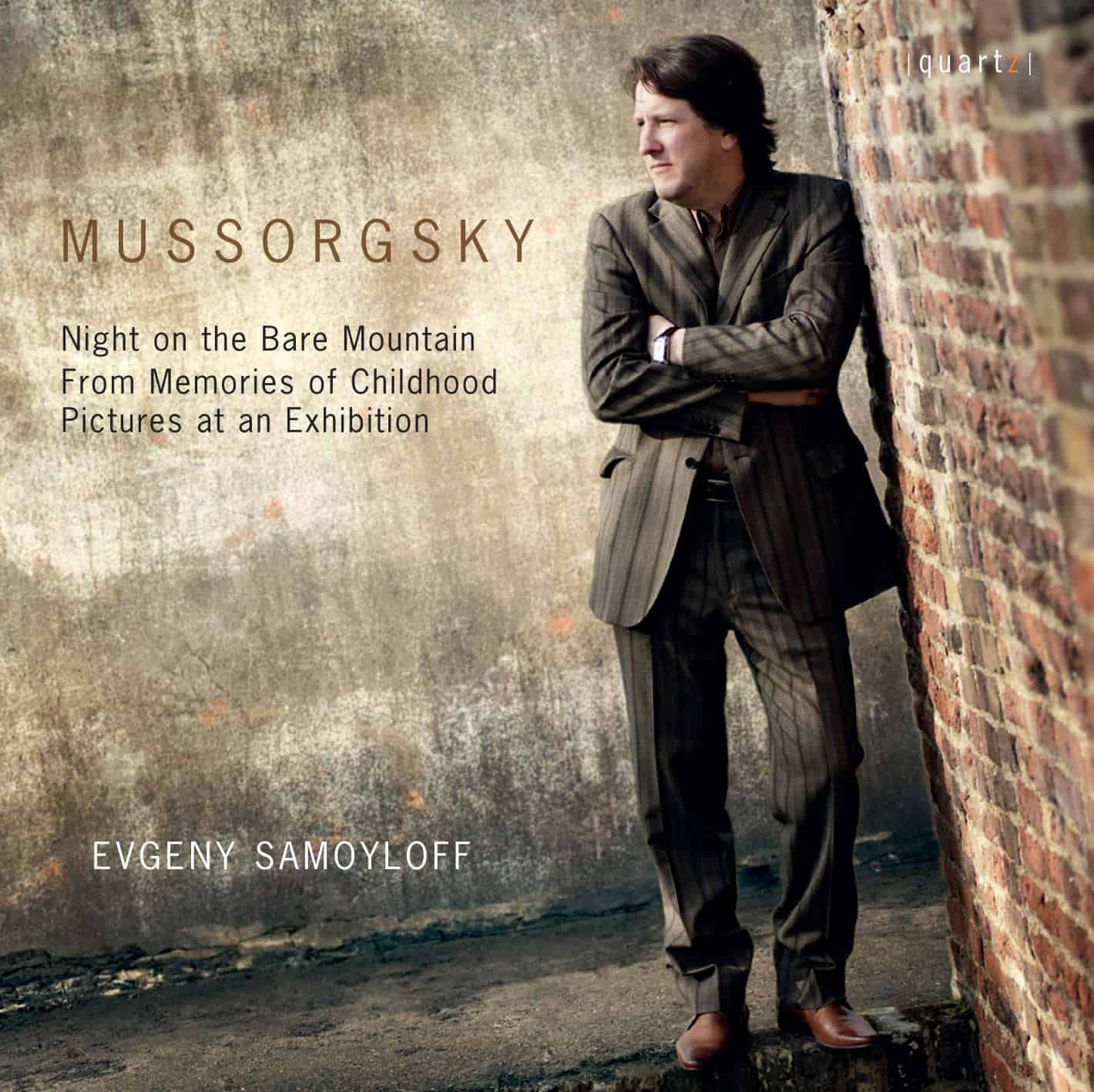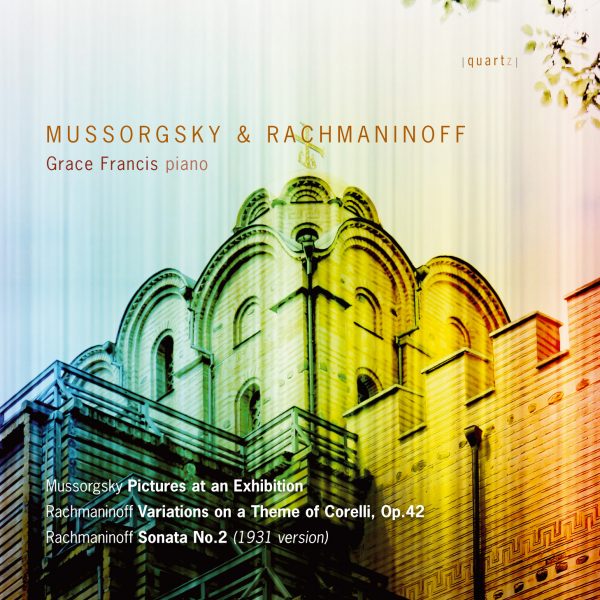Mussorgsky: Night on a Bare Mountain – From Memories of Childhood – Pictures at an Exhibition
£7.99 – £14.99
Evgeny Samoyloff writes: “Mussorgsky’s From Memories of Childhood cycle was never completed by the composer; in fact, he wrote only the first two pieces: ‘The Nurse and I’ and ‘The First Punishment’. An earlier cycle-to-be, entitled Children’s Games and featuring ‘Corners’ as its opening piece, was similarly never completed. I have taken the liberty of selecting what I believe to be the best of Mussorgsky’s miniature pieces – those that appear most complete – and of joining them to the primary cycle of Childhood Memories. I was guided by the music’s imagery and by its ‘childhood’ essence (as if seen through the eyes of a child), and I have endeavored to compile the set following the principles of contrast and artistic integrity, as well as those of tonal and architectural balance. This is how this cycle of eight pieces came into being, and I hope that it has a right to exist and to achieve widespread appeal.”
About This Recording
Children enjoy testing the boundaries of their world through stories, while adults have often used ghoulish characters in morality tales, warning children not to stray from conventional values or to venture too far into the unknown. The inspiration for Mussorgsky’s Night on the Bare Mountain was Gogol’s short story, St John’s Eve, a horror-filled folk tale unlikely to be told to children today (although Mussorgsky’s musical equivalent has become familiar to generations of children through Disney’s 1940 animation, Fantasia). Mussorgsky first contemplated writing an opera based on St John’s Eve in 1858, but it was not until 1867 that his symphonic poem, Night on the Bare Mountain, was completed. The work’s evolution was labyrinthine and numerous versions exist, including Rimsky-Korsakov’s famous orchestration of 1886. Mussorgsky explained in a letter to Rimsky-Korsakov:
“At the head of the score I’ve put its contents: assembly of the witches, their talk and gossip; Satan’s procession; obscene glorification of Satan; sabbath. The form and character of my work are Russian and original. Its general tone is hot-blooded and disordered.”
Chernov’s solo piano transcription uses an array of textures to convey a creeping, increasingly unhinged demonic procession, ultimately vanquished by tolling bells that usher in an exquisite coda. The demons are driven away and peace reigns once more.
Mussorgsky’s unfinished cycle, Iz vospominaniy detstva (‘From Memories of Childhood’), was begun in April 1865 soon after the death of the composer’s mother, to whose memory the pieces are dedicated. They were published in 1911 in an edition made by Karatïgin. The first piece, Nurse and I (Nyanya I ya), is tender and childlike, with a toddling rhythm running throughout. The child’s mood clouds towards the end of the piece, but is quickly soothed. The second piece, First Punishment: Nurse Shuts Me in a Dark Room (Pervoye nakazaniye: Nyanya zapirayet menya v temnuyu komnatu) is like a cartoon chase, a comical and breathless toccata in which the hands alternate their skittish material and dissonant chords to portray a child being scolded and frantically trying to get away before, in the witty final bars, the door shuts.
Mussorgsky wrote the quicksilver scherzo Corners in 1859; it was conceived as the first of a cycle, Ein Kinderscherz (‘A Children’s Game’). He revised the piece in 1860. Mussorgsky was studying with Balakirev at this time after leaving behind, in June 1858, a trying year with the Preobrazhensky Guards, known as “the golden youth” of St Petersburg but in reality a degenerate bunch whose routs may have contributed to Mussorgsky’s later struggles. The composer was, when he enlisted, a sensitive young man, and it may have been that the unsettling nature of this experience led him to take solace in the innocence of childhood. Balakirev was unimpressed, but Mussorgsky held the piece in sufficiently high esteem to name it, in a list given to the critic Stasov in 1878, as his Op.1, No.1.
La capricieuse (‘The Capricious Girl’) was composed in 1865 and is based on a theme by Count L. Heyden. Mussorgsky’s impressionistic material shifts between the tonal areas of E and F to accentuate the girl’s flighty mood swings, and the piece ends with an enigmatic softness.
Both the Méditation (Album Leaf) and Une larme (‘A Tear’) were written in 1880; the former was published during the same year in St Petersburg, whereas Une larme was published in Moscow later in the decade. These pieces exude a melancholy, bittersweet spirit typical of many Russian ‘romances’ (songs), and form the centerpiece of Evgeny Samoyloff’s selection for this cycle. Shveya (‘The Seamstress’) was described by Mussorgsky as a scherzino or little scherzo. He mentions starting work on the piece in 1870; it was finished in 1871 and published in 1872. Mussorgsky conjures up the seamstress at work with running semiquavers emulating the sewing machine’s constant motion, eventually slowing down towards the end of the piece.
The cycle ends with Au village (Quasi fantasia) – ‘In the village (In the style of a fantasia)’. This piece was written in about 1880 and was published in 1882, dedicated to Mussorgsky’s friend, the actor and writer Ivan Fedorovich Gorbunov, to mark the 25th anniversary of the start of Gorbunov’s acting career. Mussorgsky contrasts two main elements in this piece: a Russian folk song, its melody unfolding with haunting sparseness before it is enveloped in rich, widely-spaced chords, and a characterful dance “alla zingara” – in the gypsy style.
Children often learn to understand the world around them through pictures, and musical pictures add another layer of non-verbal interpretation to this process. Mussorgsky composed his Pictures at an Exhibition in 1874, writing about his progress in June of that year: “Hartmann is boiling as Boris [Godunov, his opera] boiled. The sounds and the idea hung in the air, and now I am gulping and overeating. I can hardly manage to scribble it down on paper… I want to do it as quickly and reliably as possible. My own physiognomy can be seen in the intermezzi. I consider it successful so far.”
Mussorgsky’s friend, the artist Victor Hartmann, had died in 1873 aged only 39. Mussorgsky was deeply affected, and while attending an exhibition of Hartmann’s paintings, some of which have since been lost, he decided to write a piano suite commemorating Hartmann and his art. Stasov had mounted the exhibition and was the dedicatee of Mussorgsky’s piece. The work is often heard in its orchestration by Ravel, but the original piano version offers a more intimate insight into Mussorgsky’s conception.
The complete work consists of ten ‘pictures’ with a recurrent Promenade theme (the ‘intermezzi’ referred to by the composer) representing the viewer, Mussorgsky himself, moving between each picture. After the imposing Promenade I we encounter the clumsy Gnome, full of ominous gestures – sullen trudging juxtaposed with bad-tempered outbursts. Promenade II is elegantly decorated in the piano’s upper register, after which Mussorgsky creates a nostalgic, romantic atmosphere as a troubadour sings outside The Old Castle. After the sonorous Promenade III we move straight to the Tuileries Garden, where children play. In contrast, the stolid trudging and robust melody of Bydlo (the Polish word for ‘cattle’) suggest a weighty Polish cart drawn by steady yet powerful oxen. A chilly version of the Promenade follows, after which we come to the playful Ballet of the Unhatched Chicks, inspired by Hartmann’s set-design for the ballet Trilby, staged by the Bolshoi Theatre in 1871, for which the children taking part were encased in eggshell costumes.
The next movement portrays “Samuel” Goldenberg und “Schmuÿle”, two different portraits by Hartmann of Jewish men, one rich, one poor. Samuel and Schmuÿle are, in fact, the same first name, one German, the other Yiddish. The paintings did not appear in the exhibition attended by the composer, but were probably given to Mussorgsky by Hartmann in 1868. Promenade V follows, then French women chat and argue in The Market Place at Limoges to music of bustling, frenetic activity, while the solemn, sepulchral Catacombs is a picture of Hartmann himself exploring the Paris catacombs by lamp-light. Cum mortuis in lingua mortua (‘With the dead in a dead language’) incorporates a veiled version of the Promenade theme, followed by the cackling grotesquery of The Hut on Fowl’s Legs. Hartmann’s picture of the witch Baba Yagá’s hut, mounted “on chicken’s legs”, may have been based on a real type of house built on tree trunks to avoid flooding. The Great Gate of Kiev is a majestic alternation of the promenade theme with a Russian Orthodox hymn-tune. Half way through the movement a march, initially sinister, unveils the main theme, which penetrates the gloom like sunlight burning through mist, building to the work’s glorious ending.
© Joanna Wyld, 2020
Track Listing
-
NIGHT ON THE BARE MOUNTAIN
- St. John's Night on Bald Mountain, “A Night on the Bare Mountain” (arr. for piano) (12’36) FROM MEMORIES OF CHILDHOOD
- No.1 Nurse and I (2’07)
- No.2 First Punishment: Nurse Shuts me in a Dark Room (1’37)
- Children’s Games: No.1 Corners, Scherzo (3’00)
- La Capricieuse (2‘46)
- Meditation (Album Leaf) ‘Razdumye’ (5’35)
- Une Larme (A Tear) (4’22)
- Shveya (The Seamstress) (2’46)
- In the Village (4’55) PICTURES AT AN EXHIBITION
- Promenade I (1’35)
- Gnomus (2’42)
- Promenade II (1’01)
- The Old Castle / Il Vecchio Castello (4’21)
- Promenade III (0’36)
- The Tuileries Gardens (1’05)
- The Polish Ox Cart / Bydlo (3’09)
- Promenade IV (0’46)
- Ballet of the Unhatched Chicks (1’24)
- Two Polish Jews: Samuel Goldenberg and Schmuÿle (2’24)
- Promenade V (1’32)
- The Market Place at Limoges / La Grande Nouvelle (1’23)
- The Catacombae / Sepulchrum Romanum (1’54)
- Cum mortuis in lingua mortua (2’00)
- Hut on Fowl’s Legs (Baba-Yaga) (3’13)
- The Great Gate of Kiev (5’03)

